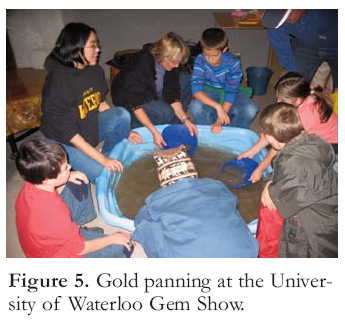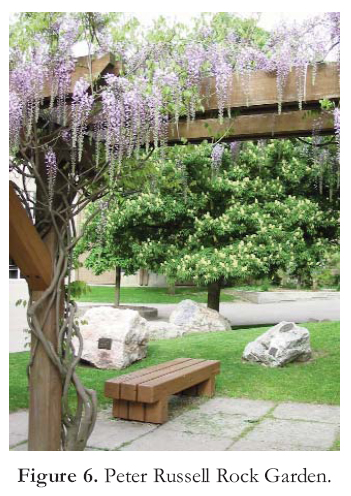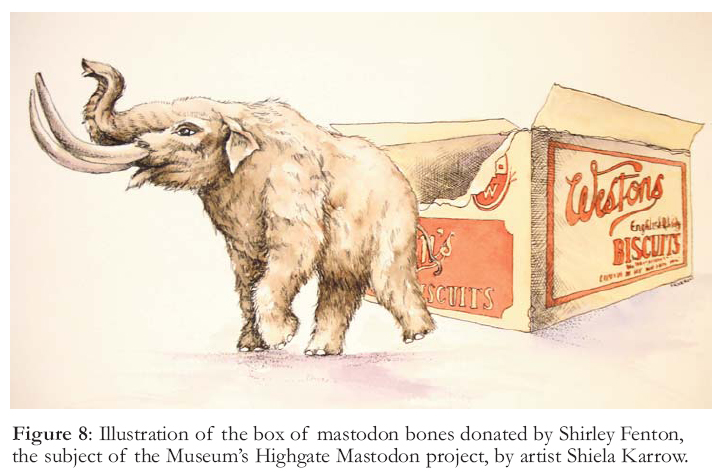Articles
The Waterloo Earth Sciences Museum
Peter I. RussellUniversity of Waterloo, 200 University Avenue West, Waterloo, ON, N2L 3G1
esmuseum@uwaterloo.ca
John E. Motz
University of Waterloo, 200 University Avenue West, Waterloo, ON N2L 3G1
SUMMARY
The University of Waterloo’s Earth Sciences Museum was started as a Canadian centennial project and has been part of the Department of Earth and Environmental Sciences outreach program for over 40 years. Museum initiatives include lectures; hands-on geological activities such as gold panning; construction of a rock garden; production of geology-themed books for children and adults; podcasts; and participation in gem shows, groundwater festivals and other public events. The museum benefits from public and private funding and the donation of specimens. Volunteers and co-op students allow it to function with a minimum of staff. It provides examples of the types of programs to increase public geological knowledge and understanding that can be offered by even a modest museum.SOMMAIRE
Le Musée des Sciences de la Terre à l’Université de Waterloo était un porjet du centennaire duCanada, et depuis a fait parti d’un programme de communication du Département des Sciences de la Terre. Les initiatives incluent des conférences; des activitiés géologiques, comme le lavage de gravier pour séparer de l’or; le développement d’un jardin de rocaille; la production de livres à thèmes géologiques pour enfants et adultes; des programmes pour iPod; et la participation à des exhibitions de pierres précieuses, des festivals de l’eau souterraine et auters activites publiques. Le musée jouit de financement publique et privé, et de dons spécimens. Des bénévoles et des étudiants permettent le fonetionnement avec le minimum d’employés. Ceci offert des exemples de programmes pour améliorer les connaissances st la compréhension de la géologie pour le grand publique qu’un musée de taille modeste peut amener.INTRODUCTION
1 Since it was started as a centennial project in 1967, the University of Waterloo’s (UW) Earth Sciences Museum has become the centrepiece of the UW Department of Earth and Environmental Sciences’ outreach program. It attracted an estimated 85 632 visitors in 2008, including 7137 visitors in 134 tour groups, and logged 17 068 hits on its website in 2007. Attendance has shown steady growth, with numbers up substantially from 9252 visitors and 3520 website hits in 2002. The museum is located at the UW Centre for Environmental and Information Technology (EIT) building, in the March Networks Exhibit Atrium and an adjoining gallery space.
2 Tour groups are generally children from schools or clubs. They can participate in talks on dinosaurs or volcanoes, and hands-on activities, such as a fossil-fish excavation or scavenger hunt. Other museum initiatives include Rock Around Town podcast tours of area cities; Dining with the Dinosaurs, which gives organizations and groups the opportunity to host functions amongst museum displays; an extensive outdoor rock garden featuring large specimens from Canada and the United States; and books about Manitoulin Island geology and groundwater.
3 The museum benefits from first-rate facilities as a result of the EIT building’s design, but in other ways it can also serve as a model for geological museums housed in more modest venues at other universities and institutions. Staff numbers are minimal, and most activities and administrative work are conducted by the curator, with assistance from volunteers and students on co-op work placements. The operating budget is small (approximately $125 000), and most acquisitions are through donations of funds or artifacts.
HISTORY
4 Conceived as a Canada centennial project, the UW Earth Sciences Museum was founded in 1967 as The Biology−Earth Sciences Museum, and opened to the public in 1968 (Fig. 1). Funding was provided by the University of Waterloo and the Ontario Ministry of Culture. It was initially housed in two rooms with a total floor area of 280 m2, in the university’s Biology One building. A geological garden was opened in May 1987. It consisted of 23 donated specimens representing various Ontario geological formations. It was renamed The Peter Russell Rock Garden, in honour of the museum’s curator, in 1999, and now contains over 50 specimens from all over Canada and parts of the United States.
Figure 1. The Earth Sciences Museum before moving to the new space in 2003.
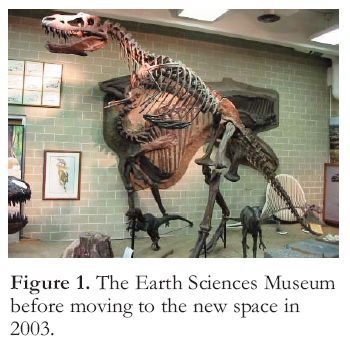
Display large image of Figure 1
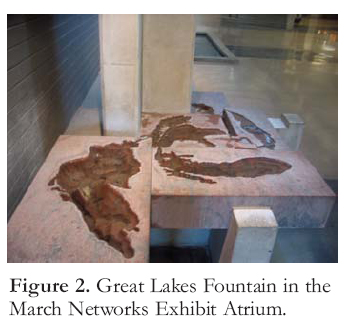
Display large image of Figure 2
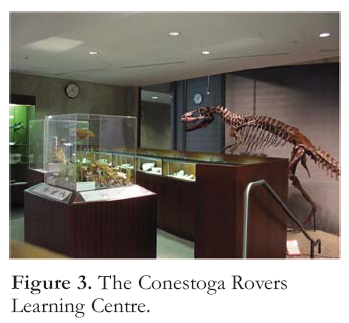
Display large image of Figure 3
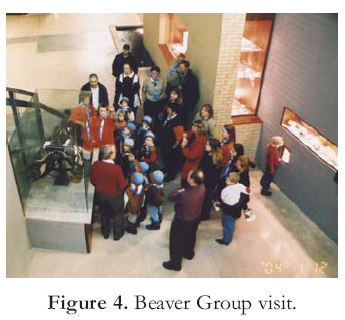
Display large image of Figure 4
5 In 1994, the Biology department withdrew its involvement and the museum became known as the Earth Sciences Museum. The museum remained in the original space until August 2003 when it was moved to the newly built EIT building. Curator Peter Russell and Cheryl Atkinson of Teeple Architects were involved in the design of the Exhibit Atrium of the EIT building, so unique facilities, optimized to accommodate museum exhibits, were incorporated into the new structure.
6 The building’s atrium is open seven days a week and houses many exhibits, including a replica Tyrannosaurus rex skull, a wall-mounted reproduction Parasaurolophus skeleton, various mineral exhibits, and an 8.5 x 1.52 x 0.53 m, 1.2-billion-year-old granite gneiss monolith from the All-stone Quarry in Northern Ontario. There is also a gneiss fountain, which is a schematic representation of water flow through the Great Lakes (Fig. 2). A gallery located adjacent to the atrium (Fig. 3) is the venue for talks to visiting groups and houses more exhibits, such as a replica Albertosaurus skeleton, an original cave bear skeleton, and a diorama recreating the environment represented in the Cambrian Burgess Shale in British Columbia. This space is open during regular university business hours.
OUTREACH PROGRAMS
Lectures
7 Talks to school classes and other groups are the central outreach activity of the museum (Fig. 4). Typically, one to three classes, Grades K to 12, participate in one and a half to two-hour sessions. They are conducted by the curator and the most popular topics are dinosaurs, rocks, and minerals. Interactive presentations to school groups are often followed by hands-on activities, such as excavating fossil fish and a scavenger hunt.
8 Lectures are also given at external venues as part of life-long learning and public interest programs. These are aimed more at adults than the in-house lectures are, and deal in a more in-depth way with topics such as, ’A Touch of Geology’ (a six-week Lifelong Learning course), ‘Shirley’s Box, The Highgate Mastodon Story’, and ‘Manitoulin Island – Rocks, Fossils, and Landscape of Manitoulin Island’.
Hands-on Activities
9 A popular hands-on activity is the fossil-fish dig. This involves using dental picks to carefully excavate fossil fish, from rocks of the Eocene Green River Formation in Wyoming. The fossil-bearing limestone is purchased in bulk from Ulrich’s Fossil Gallery in Kemmerer, Wyoming [www.ulrichsfossil-gallery.com], at $1 per piece plus shipping. This activity is portable, so it can be taken to gem and mineral shows and other off-campus events.
10 In the scavenger hunt students are given a list of items to find in the atrium, encouraging them to take a look at the exhibits. Typical questions are: The ice-age elephant is not a mammoth it is a M_S__D_N (mastodon); purple variety of quartz _M_ _ HY_T (amethyst). The 12 questions take Grade 4 students 20 minutes to complete. Older groups have a scavenger hunt without letters to assist in completing the words.
11 Gold panning is an exciting hands-on activity (Fig. 5) because most people have a touch of gold fever. Materials consist of gold, prepared specifically for panning and mixed with local sand. The gold/sand mixture is then placed in shallow, water-filled, children’s swimming pools and panned using commercial gold pans. Gold is purchased at market price, which is expensive; however, the gold is prepared for gold panning at 18 mesh size and is used sparingly, so an ounce lasts a long time. Participants take home one piece of gold taped to a card. To purchase gold for panning, contact Noreen Sailer, Box 39 Dawson, YT, Y0B 1G0, Phone/Fax 1-867-993-5080.
Rock Garden
12 The Peter Russell Rock Garden (Fig. 6) provides an opportunity for museum visitors to look at rocks in samples larger than typical hand specimens. The 50-plus rocks in the garden are very large, ranging from 50 kg to 5 tonnes, and cover a vast span of geological history, from an Archean banded iron-formation boulder from Timiskaming, ON, to quartzite from Desbarats, ON that exhibits striae engraved by a Pleistocene glacier. The rock garden is also a popular spot for faculty, staff and student lunches and coffee breaks, allowing informal learning to take place.
Figure 5. Gold panning at the University of Waterloo Gem Show.Figure 6. Peter Russell Rock Garden.Gem Show
13 Each year the Earth Sciences Museum helps host the University of Waterloo Science Open House and Gem and Mineral Show. The event takes place in the March Networks Exhibit Atrium and adjacent buildings. Features include hands-on chemistry, a chemistry magic show, mineral and gem dealers, and displays by area museums, artists and gem and mineral enthusiasts. Invited speakers give public lectures and there are demonstrations of crafts such as rock polishing, gem faceting and polishing, and stone sphere-making. Museum activities such as the fossil-fish dig and gold panning are also offered. The two-day event is typically attended by 1500 people.
Groundwater Festival
14 The museum also participates in the annual Waterloo Wellington Children’s Groundwater Festival. This event features presentations and hands-on educational activities examining such things as the physical science of groundwater; groundwater as a resource; the water cycle; the interaction and interdependence of people, plants and animals with water; an historical perspective on groundwater; and groundwater and the environment. The curator is a member of the advisory board that develops some of the activities used during the event, and participates in the presentation of activities to 4000 children per year. The Groundwater festival details may be viewed at [http://www.wwcgf.com/wwcgf/index.aspx]. The festival is associated with the Children’s Water Education Council, which assists 20 festivals throughout Ontario. Details at [http://www.cwec.ca/].
UWaterloosaurus Store
15 A dinosaur painting was commissioned for the museum and an empty store was made available free of charge at Waterloo Town Square Mall for two months while the painting progressed. Every Saturday for eight weeks the store was open to view with artist Peter Etril Snyder on hand, together with a program of children’s art and craft activities, movies and presentations.
Podcasts
16 Podcasts provide a new way to provide an informal geological education. The museum has a podcast of a two-hour walking tour around Waterloo, titled ‘Rock around Uptown Waterloo,’ which allows people to see the various building stones that have been used in their construction. The requisite movie or MP3 files, along with PDF maps, can be downloaded from the museum website. Other podcasts are being prepared, including ‘Rock around Kitchener,’ and tours of the museum and rock garden.
Visual Heritage
17 The museum assisted with geological aspects of visual heritage projects for Sarnia−Lambton and Manitoulin Island. In the Sarnia−Lambton project, Peter Russell described the formation of oil, fossils of the Arkona area and formation of concretions at Kettle Point. Fossils from the area and the diorama of Hungry Hollow fossils were photographed in our museum [http://www.visualheritage.ca/lambton/explorers.htm]. For the Manitoulin project, the curator visited the island and was interviewed at various sites to discuss the geology [http://www.visualheritage.ca/manitoulin/].
Books
18 The museum has participated in the publication of four books intended to popularize aspects of geology. The first, published in 1993, was the illustrated children’s book Wally & Deanna’s Groundwater Adventure to the Unsaturated Zone (Fig. 7). Written by Leanne Appleby and museum curator Peter Russell, with illustrations and book design by F. Restagno, the book follows the adventures of Wally the Worm and Deanna the Raindrop. Other books in the series are ‘Wally and Deanna’s Quartz Crystal Adventure’ and ‘Blackflies to Blueberries, Wally and Deanna’s Wetland Adventure’. The Groundwater Adventure has been translated into Portuguese, French and German. The book has proven popular, and has sold, as of this writing, roughly 10 000 copies in English and over 6000 copies in Portuguese (in Brazil).
19 Aimed at an adult outdoor enthusiast and naturalist market, Manitoulin Rocks – Rocks, Fossils and Landscape of Manitoulin Island is both a field guide to geologically interesting places on the world’s largest freshwater island, and an introduction to the geological concepts needed to understand them. It was written by University of Waterloo professors Mario Coniglio and Paul Karrow and curator Peter Russell, and was published by the UW Earth Sciences Museum, in partnership with the Geological Association of Canada (GAC) and the Gore Bay Museum in the town of Gore Bay, Manitoulin Island. This book has also been selling briskly.
Figure 7. Wally and Deanna’s Groundwater Adventure.Figure 8: Illustration of the box of mastodon bones donated by Shirley Fenton, the subject of the Museum’s Highgate Mastodon project, by artist Shiela Karrow.Donations to the Museum
20 Donations are a wonderful way to improve the collection and also provide publicity for the museum. Recent successes include the donation of signage for the Peter Russell Rock Garden, and enhancement of our Parasaurolophus dinosaur with the addition of a back leg and commissioned artwork. The latter project was also supported by a Canadian Geological Foundation grant. Teeth and a lower jaw tusk of a mastodon from High-gate, ON, were donated by Shirley Fenton of Waterloo (Fig. 8); the donation and accompanying story about this, the most complete Ontario mastodon ever found (now residing in Bismark, North Dakota), were featured in local and international media articles and resulted in many requests for public lectures. Google ‘Highgate Mastodon’ and follow the links! Colin Hunter of the Kitchener−Waterloo Record received GAC’s Yves O. Fortier Earth Science Journalism Award for the best Earth sciences article of 2007 for his story about the mastodon.
21 Sometimes, world-class specimens are donated to the museum. A few years ago Joseph Sönser of Kitchener, former manager at International Mogul Mine, Silvermines in the Republic of Ireland, donated spectacular crystals he had collected in the course of his job. These important mineral samples were shared with the Royal Ontario Museum. Mr. Sönser’s recollections of his career were recorded at the time and add greatly to the value of the collection.
22 Last September a donation of mining equipment from the Cobalt Historical Society was received. The ore carts, rails and mucking machine will become part of a new mining exhibit using an existing museum tunnel that will be decorated as a mine tunnel. Fundraising is taking place at present for this project.
23 Monetary donations enable us to purchase collections when they become available. Last December we obtained a collection of dinosaur artwork through partial donation and purchase. Major fundraising also created an endowment for the museum. The Conestoga Rovers Endowment allows us to hire co-op students, provide our programs free of charge to visiting groups, and support other museum projects. A fundraising effort has now started to support a full-time curator.
24 The Canadian Geological Foundation has been very supportive of our projects, providing funding for the rock garden, purchase of dinosaur replicas, book publishing, and production of a music tape/CD with Chris Rawlings.
Volunteers
25 Volunteers are a valuable resource for a museum. We have student volunteers from university, high schools, the Kitchener−Waterloo Gem and Mineral Club, and retirees. They assist with the hands-on activities for class visits at gem shows, and Canada Day and Earth Day celebrations. They also assist with writing labels, exhibit text, and the collections database.
POSSIBILITIES FOR OTHER MUSEUMS
26 Whereas the purpose-built space in the EIT building that houses the museum provides facilities much more luxurious than those available to other small museums, many of the programs and activities are possible on a modest budget. Talks – both in-house and at external venues – rely on media equipment available at most universities and other institutions, and can make use of photographs taken by faculty and staff. The key to success is a knowledgeable and enthusiastic presenter who can bring the material to life and make it accessible to a non-specialist audience.
27 Hands-on activities, such as the fossil-fish dig and gold panning, can be carried out with modest expenditures. Once again, it is important that the activity is supervised by someone who can put it into a proper geological context so that it achieves more than just keeping participants busy. Podcasts are another way a museum can provide education to the broader community at minimal expense. Using photographs and text generated by museum or institution staff, with the final result available on a website, podcasts provide a way for institutions with no museum facilities to provide an educational opportunity for the community. Even a rock garden is a possibility for a museum with some outdoor space available. By soliciting donations from local building stone and other materials suppliers, as well as collecting glacial erratics and other local stone, it should be possible to accumulate a collection of rocks that can be incorporated into campus landscaping, and combined with signage to provide some information about each specimen. Participation at local events and activities, such as gem shows and even non-geological events, e.g. Canada Day celebrations, can provide an opportunity for a museum to raise its profile and reach out to people who may not otherwise be exposed to science or geology.
CONCLUSION
28 Although geological sciences remain somewhat of a mystery to most of the public, an enduring fascination with dinosaurs, especially among children, and a general interest in gems, precious metals and other minerals, attract people to Earth science and provide the means to further learning. Small earth sciences museums are in a good position to capitalize on this by providing opportunities for their communities to take a closer look at geology in an entertaining way. The UW Earth Sciences Museum has been doing this for over 40 years and its success is demonstrated by growing attendance and interest. While other museums will have different resources, the basics of people and specimens are always present and, with a bit of imagination and enthusiasm, can be incorporated into a variety of outreach programs.
